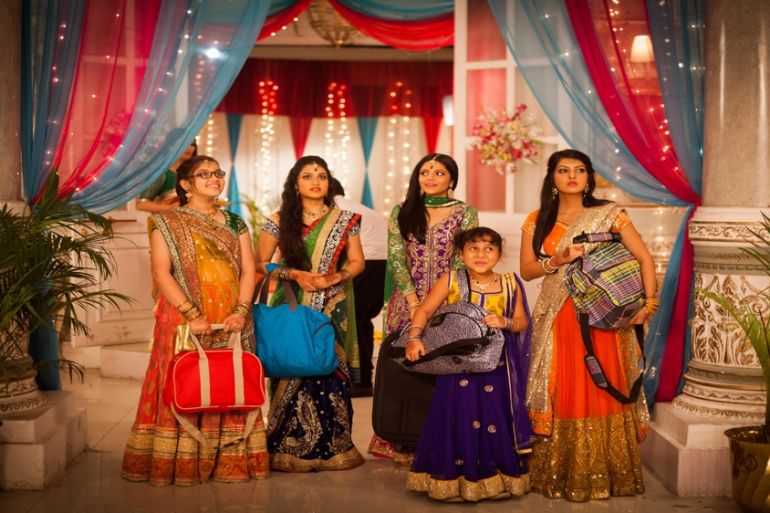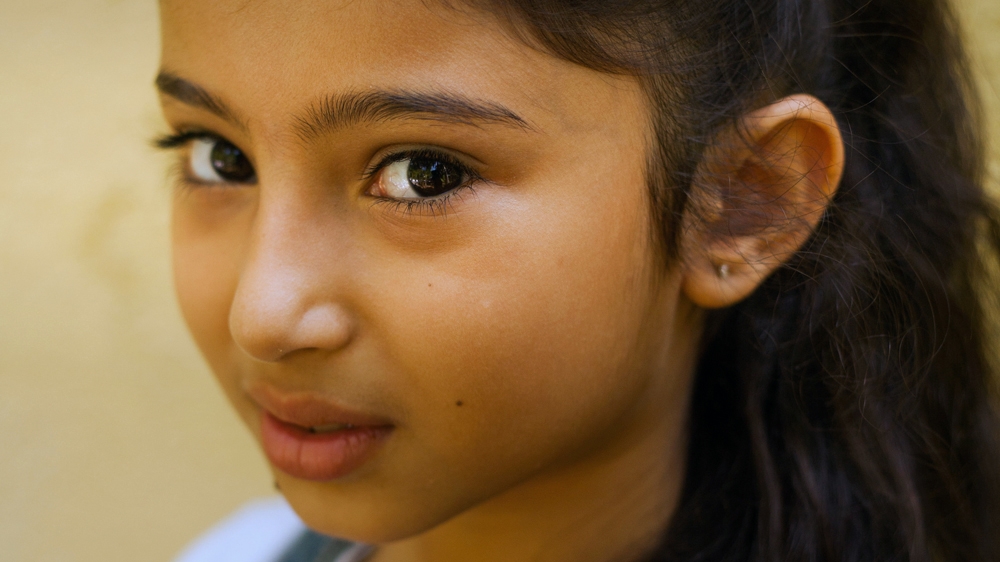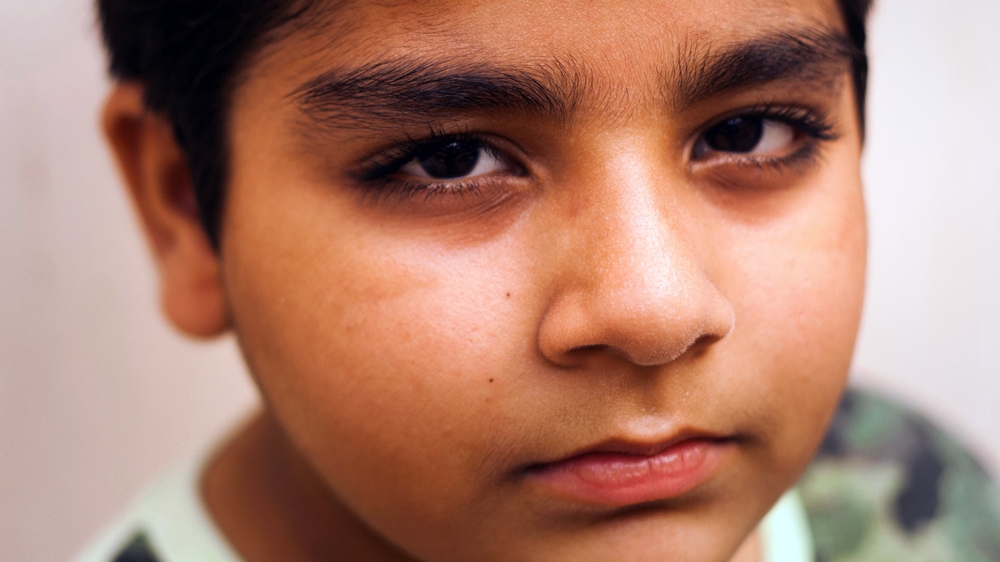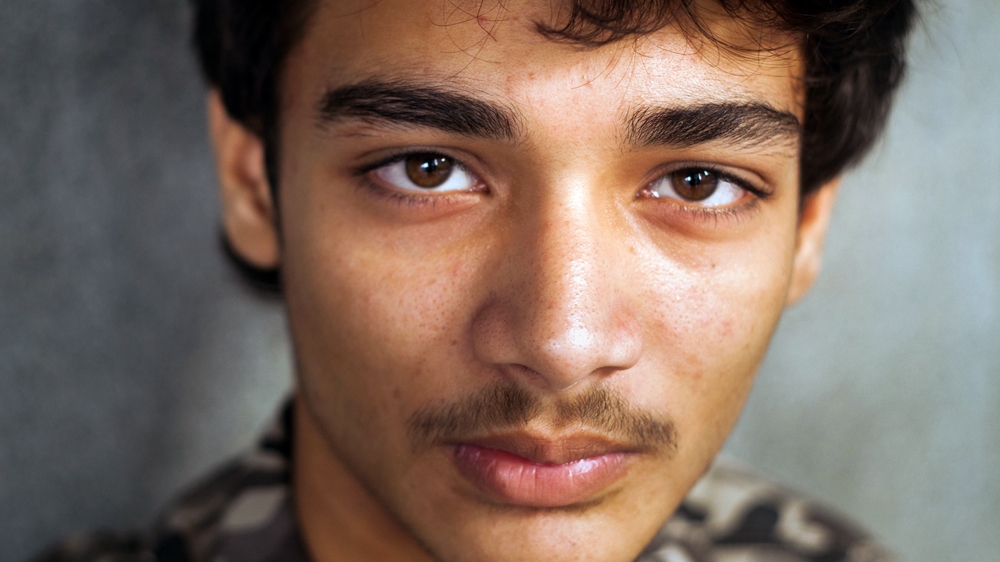Magazine: On set with India’s child actors
In India’s film and television industry, competition is fierce and expectations high – even for its youngest actors.

Riya Solanki stands in a small, windowless room in the Mumbai suburb of Andheri, holding a whiteboard bearing her name, age and phone number. Dim studio lights illuminate the whitewashed walls, crumbling with damp and age.
“I need more energy from you Riya, more mischief, more excitement,” coaxes Jocky, the casting director for the chocolate commercial she’s auditioning for.
Keep reading
list of 4 itemsA year of survival in the Turkey-Syria earthquake zoneThis article will be opened in a new browser window
‘If I die, I die’: The allure of Pakistan’s death-trap route to Europe
Lojay, the preacher’s son minting romantic anthems from stripper therapy
At 14 years old, Riya is at the upper limit of the age group of eight to 15-year-olds invited for the casting call – and it shows. With just a few commercials and brief television stints behind her, she needs to find that big break soon. Competition is fierce and the winnings can be lucrative.
Worth over $2bn, the Indian film industry churns out more than 1,600 films every year. With 788 channels and approximately 154 million households watching, the television industry is an even larger player in the country’s entertainment sector.
![Ten-year-old Saloni Burde holds a board stating her name, age and height during an audition for a chocolate commercial in a studio in Mumbai [Karen Dias]](/wp-content/uploads/2015/06/0981c21f17724e93b041b70573da19c3_18.jpeg)
A recent spate of successful kid-centric films has elevated children from mere supporting actors to central characters holding up entire plots, and more importantly, box office earnings.
With big budgets and high stakes, these children play make believe in an adult world of tight schedules and heavy responsibilities. Shoots last for hours, multiple re-takes are common and there’s limited tolerance for incompetence.
“The treatment of children on some of these film units is abysmal,” says Swati Popat Vats, the president of the Early Childhood Association, an NGO concerned with ensuring quality care for young children.
“We’ve heard stories of young children being fed coffee and sugary drinks late at night to keep them awake. Shots take place at midnight or 1am because that might be the only time that the big stars of Bollywood are available to shoot with them. Sometimes a young child is pinched to make him or her cry during a dramatic scene.”
Yet parents throng to casting calls, hoping their child will be the next superstar and eventually make the leap from adverts to full-time roles.
Amarnath Kochhar has been working as a children’s casting coordinator for commercials for the past 10 years and says he receives unsolicited photos and resumes for at least 15 to 20 children every day.
The median monthly income of an Indian household is $264, but these commercials can pay anywhere from a daily rate of $80 for a newcomer to $800 for a child star. But while advertisements are a great way to rake in the bucks, for many parents and their children, it’s not just about the money. The ultimate goal is pure, unadulterated fame.
In pursuit of fame
![Six-year-old Spandan Chaturvedi gets her hair done by a make-up artist. She plays the lead role in the TV show Udaan , in which she portrays a bonded labourer [Karen Dias]](/wp-content/uploads/2015/06/db1b70dec1404d488ce42e6350876e66_18.jpeg)
With the third-largest television industry in the world, and a burgeoning middle class obsessed with their favourite shows, daily soaps and reality TV are the gateway to instant recognition and adulation in India.
In 2008, Colors TV, an entertainment channel, premiered a show called Balika Vadhu on the subject of child marriage, packaged as a dramatic soap opera. Starring the 11-year-old Avika Gor as a young child bride, the show shot to instant popularity. Avika became a national darling and the trend of children as lead characters was firmly established.
Contending for the throne vacated by Avika is six-year-old Spandan Chaturvedi, who plays a bonded child labourer in Udaan, the latest offering from Colors with a socially relevant twist.
Every day, she commutes for two hours with her father from the outlying suburb of Ulhasnagar to the heart of Mumbai’s famous Film City, where the show is filmed. If the journey and subsequent shoot tires her, she shows no signs of it, zipping about set at the end of a long day.
But the childish frivolity is immediately dropped when it comes to work. At the end of being photographed, she unsmilingly says: “My eyes were closed during that last shot. I think you better take another one.”
![Actress Spandan Chaturvedi, in the centre with the blue collar, is surrounded by fans who travelled for almost two hours to meet her on the set of her TV show [Karen Dias]](/wp-content/uploads/2015/06/23853a6be6714f6281fa0e37d3b6f466_18.jpeg)
Commanding as much as $486 per day on set, and with shoot schedules lasting 25 days a month, a leading child actor on a daily soap can earn a fortune.
This is a league of young superstars – recognised instantly, with Facebook followers in the tens of thousands tracking every episode and promotional event – ironically fetishised as the epitome of childish innocence.
But the climb to the top is long and the television industry has earned a special level of notoriety in its treatment of young actors.
Mukul Chhabra, a Mumbai-based casting director, balks at the very mention of TV. “I refuse to have anything to do with those shows. It’s absolutely inhuman how those children are made to work.”
Students and superheroes
![Eight-year-old Palak Dey is fed her dinner by her mother, Mamta Dey, at 11pm in the dressing room on set. Palak often spends 12 hours a day on set and sometimes has to skip school to accommodate her shooting schedules [Karen Dias]](/wp-content/uploads/2015/06/4f7e13e66d254b8586586f6d1389badd_18.jpeg)
It’s almost 9pm and eight-year-old Palak Dey is prepping for another sequence on set.
There are still a few hours to go before her 12-hour shift ends at two in the morning, but she’s already feeling tired. “I don’t want to shoot, I’m sick,” she complains to her mother in the universally recognisable tone employed by children trying to get out of going to school.
It’s only a temporary tantrum though. Palak knows there are no off days on screen, and after a 20 minute power nap, she’s back to mingling on set, calling for the make-up artist to touch up her blush.
She comes back after the shot and bemoans how short her dialogue was, hungry for the spotlight.
“It’s not a lead, but she’s the youngest character and a lot of focus is on her,” says her mother Mamata proudly.
“Yes the schedule can be tough but her school is very understanding about missing classes. She’s been acting since she was four and they know she’s famous. If her notebooks are incomplete, the teacher just fills them and sends them to us. Thankfully, she’s an outstanding student.”
‘Outstanding students’ and ‘understanding schools’ are a common refrain among parents.
Fourteen-year-old Dev Joshi is from Ahmedabad, a city 525km north of Mumbai. While he’s enrolled in a school in his hometown, for the last two-and-a-half years, he has spent 20 days each month in Mumbai shooting for his show, Bal Veer , where he plays a young superhero living between the human and fairy world, often rescuing children from harm.
“I end up doing almost all his projects and assignments and sometimes get his friends to take photos of the lessons for the day and send them to me,” says his mother Devangana.
As usual, his school understands and the show lets him return whenever there are urgent examinations to be taken.
‘A source of income’
![Fourteen-year-old Dev Joshi (in blue) rehearses his dialogues with a director and other child actors, 10-year-old Rudra Soni, 11-year-old Shruthi Bisht and 12-year-old Anushka Sen on a set in Mumbai. Dev Joshi plays the lead role in a show about the adventures of a boy with supernatural powers [Karen Dias]](/wp-content/uploads/2015/06/f72d16d819ac4a52b257aa162cd9f6e2_18.jpeg)
The trade-off for missing out on a formal education is high. Apart from his earnings from the show, he frequently performs at events as his famous character, charging between $1,215 for a show in Mumbai to $2,430 for an out of town event.
“He always wanted to be famous. At some of these shows, he needs four or five bodyguards. One time, we had to escape a school science fair in a police van because the crowd got so unruly,” beams Devangana.
The National Commission for Protection of Child Rights (NCPCR) issued guidelines in 2011 for on-set behaviour. Among other things, these include: the avoidance of inappropriate or distressing roles for children, ensuring school hours are not compromised, regulations on the number of hours of shooting, and the presence of a child care professional on the production unit.
But awareness of, let alone adherence to, these guidelines is low.
Gajenda Chauhan, the president of CINTAA, an artists’ association that seeks to safeguard the interest of cine and TV actors, says a vigilance committee conducts surprise visits four times a month to TV sets to ensure there is no mistreatment of child actors. He says the committee hasn’t found a single instance of these guidelines being violated.
But a producer on a show with a cast predominantly comprised of children spoke, on condition of anonymity, of his wariness at the growing popularity of this trend. “These kids are missing out on a normal childhood, forced to grow up before their time. I have two children of my own and I would never let them anywhere near a set.”
He added: “When parents show up at auditions with a two-year-old child, it’s clear they’re chasing an unfulfilled ambition of their own or hoping to turn their child into a source of income.”
Intended as a means to combat the latter problem, one of the recommendations of the NCPCR was that a minimum of 50 percent of a child’s payment must be set aside for them in fixed deposits or bonds that mature when they reach the age of 18. Most of the parents, however, have no knowledge of this rule and several channels seem to flout it.
‘Everybody knows me’
![Spandan Chaturvedi's mother helps her put on her shoes as she gets ready in the dressing room. Her six-year-old co-star, Tasheen Shah, looks on [Karen Dias]](/wp-content/uploads/2015/06/4414521d5f0a49d6b46fce969b9ac2fb_18.jpeg)
Back in Film City, Spandan Chaturvedi’s father, Sunil, is referring to her shoot experiences in the first person, a disconcertingly common trait among the parents of child stars.
“I’ve done ads and TV shows before, but this is definitely the big break. The channel bargained hard for the day rate but there’s lots of visibility and Udaan promoted us heavily, so I think it wasn’t a bad deal,” he says.
Running a group of coaching classes for high school students, Sunil doesn’t have to go in to work much these days and most of his time is spent on set.
On learning that Sunil is from the same suburb as them, the patriarch of the family is barely able to contain his excitement. The cameras are repositioned and Sunil finds himself at the centre of the group, smiling indulgently and telling the group: “Ask anyone in Ulhasnagar where I live. Everybody knows me there.”
______________________________________________________________________________________
Some of India’s child actors share their stories
Sara Arjun: The go-to girl
| Sara Arjun | |
“Sometimes we carry her [to work] while she’s still sleeping,” says Sara’s father, Raj [Karen Dias] |
Nine-year-old Sara Arjun asks for her father’s phone from his pocket. “Don’t worry I’m not going to take another selfie. I just need to check that I’m looking good,” she says.
But she’s not pleased with what she sees; smoothening down wisps of hair that came loose during the gymnastics class she’s just finished.
In addition to these weekend classes, she attends vocal classical training, drawing and art classes, classical dance, and Tamil language classes throughout the week, while balancing fourth grade school and a full-fledged film career.
After appearing in a short film just before she turned two, Sara has since shot nearly 150 commercials, promoting products from coffee beans to housing loans. Her big break, however, came at the age of four when she was cast in the award-winning role of the daughter of a mentally challenged man in a South Indian adaptation of the acclaimed Hollywood film I Am Sam.
“Since then she’s the go-to girl whenever casting directors are looking for a beautiful girl who can act as well,” beams her father Raj, who is also an actor.
Despite a schedule that is bursting at the seams, Raj insists the family is keen to retain a semblance of childhood for Sara, a reason he gives for keeping her away from the hectic life of TV shows.
Having become a household name in the immensely popular regional cinema of southern India, where she commands anywhere from $8,100 to $16,200 per film, she doesn’t have to attend too many auditions these days. But life on film sets is still demanding.
Raj explains: “Sometimes we carry her while she’s still sleeping and put her in the car and wake her up only when we reach the set. She brushes and bathes in the vanity van.”
Long waiting times between shots are dealt with through an iPad loaded with films, particularly those featuring her favourite actors – Amitabh Bachhan and Angelina Jolie.
Her mother Sania, a former dance instructor, has now quit teaching and is a full-time companion on set. The entire family often goes along for long shoots.
Acutely aware of the thick skin required for the industry, Sara laughs away her parents’ talk of the challenging scenes she’s had to shoot. “My mother was scared about a scene where my skirt catches fire but I absolutely insisted on doing it. I wasn’t worried with the director on set,” she says.
But she does concede that the day of shooting she’s just wrapped up – which started at six in the morning and ended at 10pm – may have been exhausting.
Still, she says she wants to be a “film all-rounder” when she’s older – an actor, director, photographer, everything except production in fact.
“I don’t like to waste money like these producers do,” she says, with a perfectly practised, imperious toss of her hair. “But I’ll easily be able to hire someone to do that part for me.”
______________________________________________________________________________________
Sadhil Kapoor: Portraying divinity
| Sadhil Kapoor | |
“He had fans come to meet him from all over the world,’ explains Sadhil’s father, Kunal [Karen Dias] |
“He had fans come to meet him from all over the world,” recalls Sadhil’s father Kunal Kapoor, a real estate agent.
“This one time, a 60-year-old lady came from the UK just to see him and waited on set for six hours till we arrived to shoot.”
For an entire year of his life, Sadhil Kapoor would go to work, and sit patiently in a vanity van for up to two hours while a prosthetic rubber trunk and floppy ears were attached to his face. He would then shoot for six to seven hours, after which it would take another hour to remove his artificial trunk.
Six-and-a-half years old at the time, Sadhil had hit the big league – playing the young Ganesha, the Hindu elephant god, on the most popular mythological show on Indian television, Devon Ke Dev Mahadev.
Portraying divinity came easily to him – he had already played the monkey god Hanuman on another show. But this was primetime viewing, catapulting him onto an altogether different playing field.
Having started from a humble $16 a day on his first show, he was now pulling in 10 times that amount, just a year-and-a-half after his debut.
But the line between actor and character can sometimes get blurred. A family that came to visit him from a nearby city fell at his feet in prayer, crying tears of joy. “Of course it was uncomfortable for Sadhil but we’ve told him to make them get up and hug him instead when that happens,” says Kunal.
With 10-hour shoot schedules almost every day of the month, half days or holidays from school became the norm for the year he was the only child in the production. For one particularly gruelling sequence, father and son spent three days straight on set.
The make-up department had to experiment heavily with the prosthetics before getting them right. Sometimes, the fine hairs on his young face would get ripped off in the process.
Yet Sadhil looks back fondly on his stint. “I enjoyed shooting for the show because everybody loved my character and I got a chance to speak in proper Sanskrit. While the trunk was really hot and sweaty, thankfully there was a portable air conditioner where I could cool off,” grins the nine-year old, who has just finished auditioning for a commercial for a brand of biscuits and seems confident of his chances.
Having hung up his trunk and ears, Sadhil has spent the last few months working as a chat show host on Disney India, where he exchanged light-hearted banter with some of the country’s most famous actors, comedians and sports stars. But he’s hungry for more and wants to be an action star when he’s older.
“We’re considering introducing his younger sister into the business soon but she’s still just four-and-a-half,” smiles Kunal. “We’ll wait another year until she’s old enough.”
______________________________________________________________________________________
Saloni Daini: The child comedian
| Saloni Daini | |
“When she was on comedy shows as a young child, she couldn’t even read the scripts,” says Saloni’s mother, Sanyojita [Karen Dias] |
It’s 9pm and 13-year-old Saloni Daini has just gotten home. She’s had a long day of school, followed by basketball and tuition classes for French.
Her mother, Sanyojita, is glued to the giant LED TV in the living room, on which the top-rated show Udaan is playing.
“I don’t really care for the show too much but the little girl who plays the lead role is just too adorable,” she gushes.
Disinterested in the drama unfolding on screen, Saloni scrolls through her phone. Hers is a world of reality TV and these daily soaps hold no fascination for her.
One of the most successful child comedians on Indian television, Saloni spent three years on Comedy Circus , a reality comedy competition with acts featuring characters such as her favourite GanguBai – a feisty domestic maid full of complaints about her employers.
While she ruled the roost as the only child among the roster of professional comedians, Sanyojita decided her daughter needed a break after a couple of years.
“She would shoot for two episodes in one day and had to memorise 15-page scripts with just a day’s notice. I’ve always helped her with the preparation. When she was on comedy shows as a young child, she couldn’t even read the scripts and I would read them out to her. Her father [a pharmaceuticals executive], and I thought it’s time she focused on her studies.”
In a comic world ruled by ribald humour, children grow up fast. While Sanyojita insists Saloni never had to utter anything that was inappropriate for a nine-year-old, innuendo-laden histrionics and smutty jokes were a common identifier of the show.
She has since hosted award shows, guest starred on popular quiz shows and reality competitions, and performed at private corporate events. It’s a rewarding business. Her favourite comedian, Kapil Sharma, on whose show she’s made special appearances, is rumoured to be one of the top earners on television, making up to $16,200 per episode.
“I do miss being on TV but I visit the sets sometimes as a guest,” Saloni says.
In stark contrast to her exuberant, larger-than-life persona on screen, Saloni is quiet and reserved in person.
While no longer a weekly regular on television, she’s been busy working on her YouTube channel called Some Madness With Saloni. “Everything is online now anyway. And this is my very own solo show,” she says whipping out her iPhone to show the only video that’s been released so far.
As soon as the camera comes out, she immediately reverts to what she knows best. The shyness falls to the wayside and poses are struck with automatic ease – thumbing her nose at the camera, sticking her tongue out and making faces – a child performing the role she’s been honed for.
______________________________________________________________________________________
Ayush Tandon: Looking West
| Ayush Tandon | |
“Our house was flooded with news crews when the film was released,” explains Ayush’s father, Hatinder [Karen Dias] |
Ayush Tandon has a look of determination on his face as he speaks about his upcoming role. “I play both my conscious and sub-conscious self. While one is excitable and a little crazy, the other is a little sad, quite like myself,” he laughs.
The 16-year-old has little to be sad about at the moment. He’s excited about playing the lead character in a professional Hollywood film and has been in rehearsals for about four months.
With the fuzz of an emerging mustache clouding his upper lip and a lean lanky frame, he barely resembles the character that opened up the gates of cinema to him. Four years ago he was in Taiwan, still unable to believe that he had been cast as a younger version of the titular character in the Ang Lee directed film, Life of Pi .
“I auditioned for the role in Mumbai and one week later got a call to come to Taiwan for a look test. I was approved on the spot and began shooting right away,” he recalls excitedly.
“Ang Lee was so impressed with my performance that he still makes a mention of it. Some time ago, he was in Mumbai for a press conference and he called me to the hotel and introduced me to all his friends over lunch.”
Ayush has acted in several commercials and a couple of Bollywood films in the past, and has another one in the pipeline, but his gaze is firmly set on the West. “There’s a level of sincerity and discipline there which is difficult to find here. I want to hone my skill as an actor and hopefully take home the Oscar one day.”
His father Hatinder, who is also an actor, smiles indulgently. “Our house was flooded with news crews when the film was released. He got almost daily offers afterwards, especially for TV series, but we declined them. That’s no life for a child and there was no scope for him to evolve as an actor. And he had to take a couple of years off to concentrate on high school.”
Far from letting celebrity go to his head, Ayush shrugs off the possibility of becoming a star in school. “Why would I be anything but normal with my friends at school?” he asks. “Right now all I want to focus on is breaking out of the child actor mold.”
This article first appeared in the November 2014 issue of the Al Jazeera Magazine. For more compelling stories, download the magazine for iPads and iPhones here , and for Android devices here .



